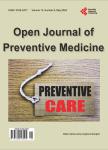Epidemiological Patterns of Work-Related Musculoskeletal Disorders among Healthcare Workers in Five Reference Hospitals in the City of Douala, Cameroon
Epidemiological Patterns of Work-Related Musculoskeletal Disorders among Healthcare Workers in Five Reference Hospitals in the City of Douala, Cameroon作者机构:Department of Animal Biology and Conservation Faculty of Science University of Buea Buea Cameroon Physiology and Medicine of Physical Activities and Sports Unit Faculty of Sciences University of Douala Douala Cameroon Department of Physiology Faculty of Medicine and Biomedical Sciences University of Yaoundé I Yaoundé Cameroon Department of General Medicine Faculty of Medicine and Biomedical Sciences University of Yaoundé I Yaoundé Cameroon Mines Saint-Etienne INSERM Université Jean Monnet Saint-étienne France
出 版 物:《Open Journal of Preventive Medicine》 (预防医学期刊(英文))
年 卷 期:2023年第13卷第5期
页 面:109-128页
学科分类:0202[经济学-应用经济学] 02[经济学] 020205[经济学-产业经济学]
主 题:Work-Related Musculoskeletal Disorders Risk Factors Prevalence Healthcare Workers Douala-Cameroon
摘 要:Introduction: Work-related musculoskeletal disorders (WRMSDs) are a public health problem and have forced many workers to quit their jobs prematurely. This study investigated the prevalence and risk factors of WRMSDs among Healthcare workers in five reference hospitals in the City of Douala-Cameroon. Methods: A cross-sectional study was conducted in 2022 among 561 healthcare workers working in five reference hospitals in the city of Douala, Cameroon. Participants were selected using a convenient sampling technique. Data were collected with structured questionnaires;data on the demographics and risk factors were collected using a well-designed questionnaire, while estimation of the prevalence of WRMSDs was done using the Modified Nordic questionnaire. Results: The overall prevalence rate of WRMSDs among healthcare workers in Douala hospitals was 83.4% (468/561). The prevalence per professional groups was as follows: 88.8% (71) for Medical Laboratory Scientists (MLS), 81.9% (289) for nurses, 21 (80.8%) for Physiotherapists (PTs) and 78.8% (41) for Medical Doctors (MDs). There was a significant difference (p = 0.001) in the prevalence of WRMSDs with respect to place of work where healthcare workers from HLD recorded the highest prevalence 89.9%, while Healthcare workers from NBDH were 2.91 times at risk (AOR = 2.91;95% CI: 1.32 - 6.41;p = 0.001) to develop WRMSDs than healthcare workers in the other hospitals. With respect to body region, the highest prevalence of WRMSDs was recorded on the lower back, 58.8% with the lowest at the elbows 11.2%. The age group 30 to 39 years was significantly associated with WRMSDs at level of the shoulder (p = 0.002), upper back (p = 0.019), elbows (p Conclusion: The overall prevalence rate of WRMSDs among healthcare workers in Douala hospitals was high. The prevalence of WRMSDs is highest among MLS and nurses and the most affected body parts are;lower back, neck and upper back. Working on the same posture, stressful job, and repetitive



